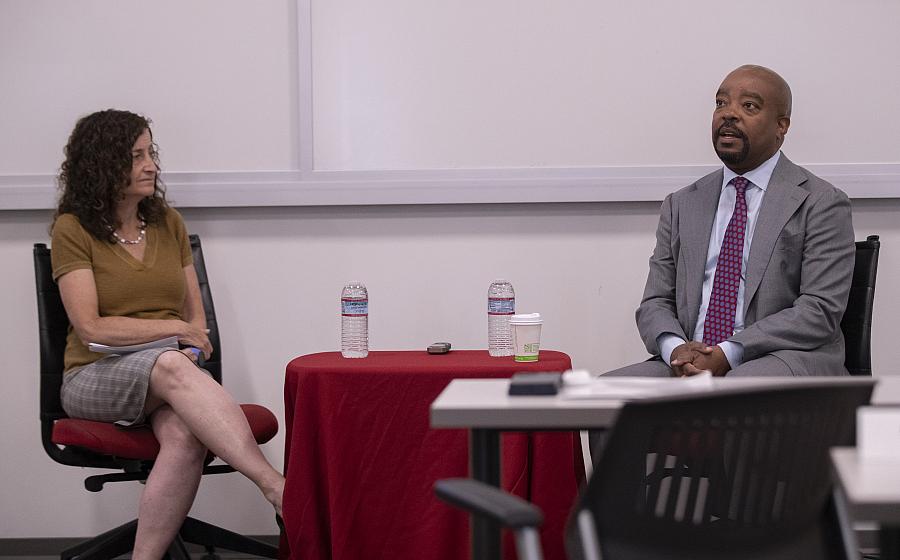The Black youth suicide crisis is “like a house on fire,” expert says

Michelle Levander talks with Dr. Michael Lindsey at the Center for Health Journalism 2023 National Fellowship in Los Angeles.
2023 National Fellow Chris Juhn
Three years after an emergency task force of the Congressional Black Caucus documented an alarming increase in suicide among Black youth and recommended action, Dr. Michael A. Lindsey, who led the expert group that supported the work, says the crisis is like “a house on fire, because it’s burning out of control and no one is doing anything about it.”
Lindsey, the Dean and Paulette Goddard Professor of Social Work at NYU Silver School of Social Work, discussed the factors fueling the increase and outlined policy solutions at the USC Center for Health Journalism 2023 National Fellowship in Los Angeles earlier in July, in conversation with Center Director Michelle Levander.
In 2020, the task force reported that the suicide rate among Black children and teens was increasing faster than that of any other racial or ethnic group. Although Black youth were not considered to be at high risk of suicide historically, their suicide rate nearly doubled from 2007 to 2017, and Black boys ages 5 to 11 were more likely than their white counterparts to take their own lives.
The rate of suicide attempts by Black adolescents increased by 73%; for boys, the rate of attempts that resulted in injury rose by 122%.
Instead of addressing the undercurrent mental health issues or other conditions youth struggle with — for instance, food or housing insecurity — that may manifest as problematic behaviors or the impulse to self-harm, our society demonizes and criminalizes Black youth, Lindsey said. Schools in low-income communities of color lack adequate mental health services; all too often, there are no mental health professionals on staff or someone who comes in a day a week.
What these schools do have, Lindsey noted, are police officers.
“To me, it’s just so striking that we are quick to respond in punitive ways. And seemingly we don’t see the humanity that is deserving of professional support and services proximal to where the challenges are in schools,” he said.
A separate study he was involved in, led by Dr. Arielle H. Sheftall, looked at Black youth suicide trends from 2003 to 2017. It found that suicide increased in all age groups, and fastest among teens ages 15 to 17. Many more boys than girls committed suicide, but girls seemed to be closing in; their annual suicide rate increased more than twice as fast as that of boys.
Such rates of change, Lindsey noted, underscore the need to limit access to the means of committing suicide. Research has shown a link between suicide risk and increased capability to commit the act, even in the absence of suicidal thoughts or plans, he said.
COVID-19 accelerated the crisis, he said; school closures, separation from friends, and the deaths of family members and neighbors took a significant toll on the mental health of all youth and especially those from the communities hit hardest by the pandemic.
But the rapid rise in Black youth suicide began well before the pandemic, and more research is needed to understand why. ”The fact of the matter is that we don't know,” he said. “That data is not available.” He called for legislation to allocate funds to investigate the issue.
Lindsey outlined additional steps to address suicide not only among Black youth, but also communities of color and LGBTQ youth. Among the recommendations: limit access to lethal methods used for suicide; establish a system in emergency rooms to triage youth at risk for suicide into outpatient treatment; make sure social workers and other mental health professionals are available in all schools in numbers proportionate to the student population; and increase the number of mental health professionals and researchers who are reflective of communities.
Lindsey alo believes that introducing educational campaigns, interventions and services such as mental health support and first aid into Black communities would help loved ones and neighbors understand the signs of mental distress and how to address it.

